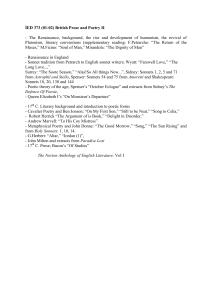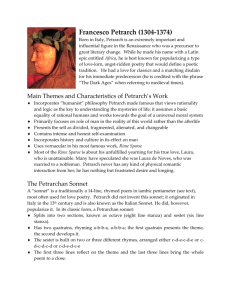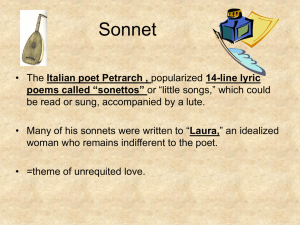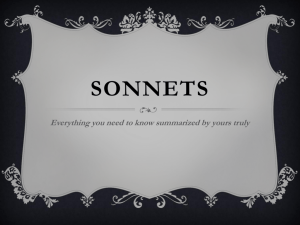An Introduction to Sonnets - Miss Van Ness's English Class
advertisement
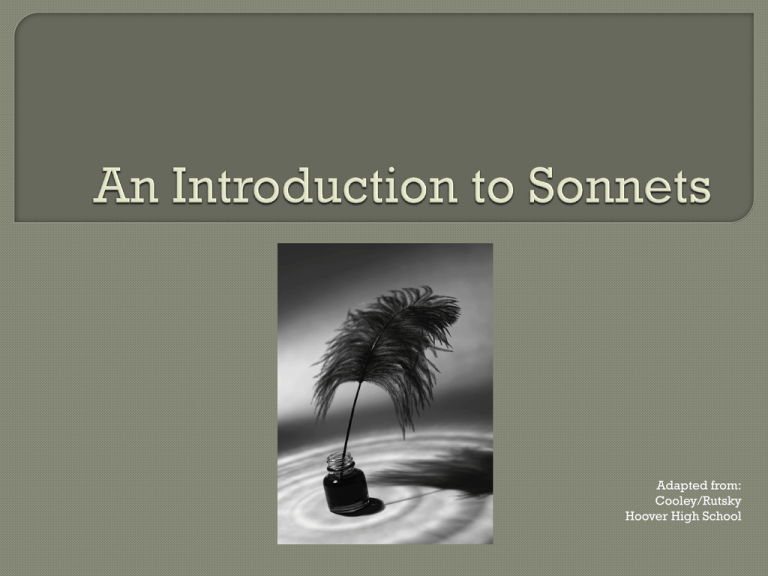
Adapted from: Cooley/Rutsky Hoover High School • Sonnets are poems that meet the following rules: 1. All sonnets are 14 lines long. 2. Sonnets in English are written in iambic pentameter, which means that each line has 10 syllables, alternating in an unstressed/stressed pattern. 3. Sonnets follow a predetermined rhyme scheme; the rhyme pattern determines if the sonnet is Petrarchan (Italian), Shakespearean, or Spenserian. 4. All sonnets are characterized by a “turn” located at a designated point in the sonnet. The sonnet began in Italy, where the poet Francesco Petrarch first established it as a serious form of poetry. Petrarch wrote a large collection of sonnets addressed to a young woman named Laura he saw one afternoon at church. She was not interested, but he didn’t let that stop him, and proceeded to publish some 260 sonnets about her—followed by another hundred or so after her death. Petrarch is, quite possibly, the first recorded literary stalker. In these sonnets, Petrarch used witty plays on Laura’s name (l’oro = the golden one or the golden; references to laurel trees, etc.) to both honor and attack the object of his affection. He would praise her for her beauty in one sonnet, then condemn her as an icy monster who rejects his love in another. Laura was completely unable to respond to these poems, as women did not write, and her public persona was thus basically Petrarch’s to define. Passion impels me, Love escorts and leads, Pleasure attracts me, habits old enchain, Hope with its flatteries comforts me again, And, at my harass’d heart, with fond touch pleads. Poor wretch! It trusts her still, and little heeds The blind and faithless leader of our train; Reason is dead, the senses only reign: One fond desire another still succeeds. Virtue and honour, beauty, courtesy, With winning words and many a graceful way, My heart entangled in that laurel sweet. In thirteen hundred seven and twenty, I -- ‘Twas April, the first hour, on the sixth day – Enter’d Love’s labyrinth, whence is no retreat. Elizabethan Turn Age (1558 – 1603) to page 232 in your textbook Petrarch • ABBA ABBA CDECDE Spencer • ABAB BCBC CDCD EE Shakespeare • ABAB CDCD EFEF GG Sidney was praised by those of his generation as the consummate courtier, the man who best exemplified the social, political, and aesthetic qualities demanded of those who served the queen and her state. His career required some degree of excellence in the following areas of competence: poetic composition (of course!), political strategy, military tactics, rhetoric, aesthetics, and philosophy. Sir Philip Sidney was mortally wounded in battle under the walls of the stronghold Zutphen, in the year 1586. Despite his injury, he managed to escape from the conflict and reach the English camp, which was a mile or two distant. There, parched for thirst, he called for a drink. A bottle of water was brought, but as Sidney was placing it to his lips, a grievously wounded soldier was borne past him. Rather than taking a drink himself, Sidney at once handed the bottle to the soldier, with the famous words: “They necessity is yet greater than mine.” sonnet’s turn is the point in the sonnet where the poet changes perspective or alters his/her approach to description. This often results in a sonnet following a “position-contrasting position” type of structure, or occasionally a “change of heart” in the poet at the end of the verse. Look at this sonnet as an example: A In the next poem, notice that the poem’s turn is a change from discussing what Sleep itself is to what the poet will offer Sleep as tribute if Sleep comes to him. “Come Sleep, O Sleep!” By Sir Philip Sidney Come, Sleep! O Sleep, the certain knot of peace, The baiting-place of wit, the balm of woe, The poor man's wealth, the prisoner's release, Th' indifferent judge between the high and low; With shield of proof shield me from out the press Of those fierce darts Despair at me doth throw! O make in me those civil wars to cease! I will good tribute pay if thou do so. ------------------------------------------------------------------------Take thou of me smooth pillows, sweetest bed, A chamber deaf of noise and blind of light, A rosy garland, and a weary head; And if these things, as being thine in right, Move not thy heavy grace, thou shalt in me, Livelier than elsewhere, Stella's image see. Recap: How many lines are in a sonnet? How many syllables are in each line? What is the turn? A B B A A B B A C D E C D E Petrarchan (Italian) Octave (8 lines) The TURN Sestet (6 lines) A B A B C D C D E F E F G G Shakespearean 3 quatrains The TURN Rhyming Couplet Petrarch also refined a particular type of sonnet known as the blason (blah-zohn). A blason is a sonnet that catalogues the features or traits of its subject, usually a woman, and describes them using hyperbole, metaphor, or simile. What tongue can her perfections tell, In whose each part all pens may dwell? Her hair fine threads of finest gold, In curled knots man’s thought to hold: But that her forehead says, “In me A whiter beauty you may see”; Whiter indeed, more white than snow, Which on cold winter’s face doth grow. That doth present those even brows Whose equal line their angles bows, Like to the moon when after change Her horned head abroad doth range; And arches be to heavenly lids, Whose wink each bold attempt forbids. For the black stars those spheres contain, The matchless pair, even praise doth stain. Sir Philip Sidney Note how Sidney lists off the elements of the woman’s face—hair, forehead, eyebrows, eyelids, and finally, eyes. This is the source of the “your eyes are like deep pools I could dive into, etc.” school of poetry, which, while occasionally flattering, should be noted as being problematic as well, as it reduces the subject to nothing more than a collection of good-looking body parts. This objectification of the subject, usually a woman, has in turn contributed to the impossible standards of beauty for women today, as well as the problem of seeing women only as objects of sexual desire. My mistress' eyes are nothing like the sun; Coral is far more red than her lips' red; If snow be white, why then her breasts are dun; If hairs be wires, black wires grow on her head. I have seen roses damasked, red and white, But no such roses see I in her cheeks; And in some perfumes is there more delight Than in the breath that from my mistress reeks. I love to hear her speak, yet well I know That music hath a far more pleasing sound; I grant I never saw a goddess go; My mistress when she walks treads on the ground. And yet, by heaven, I think my love as rare As any she belied with false compare. Giuseppi Archimboldo’s Summer William Shakespeare, Sonnet CXXX All we need is fourteen lines, well, thirteen now, and after this one just a dozen to launch a little ship on love's storm-tossed seas, then only ten more left like rows of beans. How easily it goes unless you get Elizabethan and insist the iambic bongos must be played and rhymes positioned at the ends of lines, one for every station of the cross. But hang on here while we make the turn into the final six where all will be resolved, where longing and heartache will find an end, where Laura will tell Petrarch to put down his pen, take off those crazy medieval tights, blow out the lights, and come at last to bed. Billy Collins

